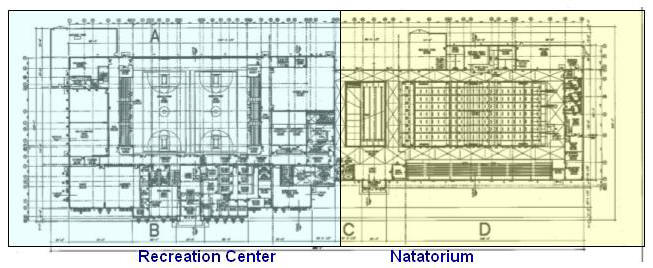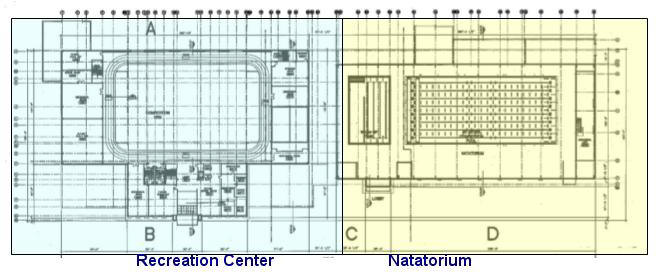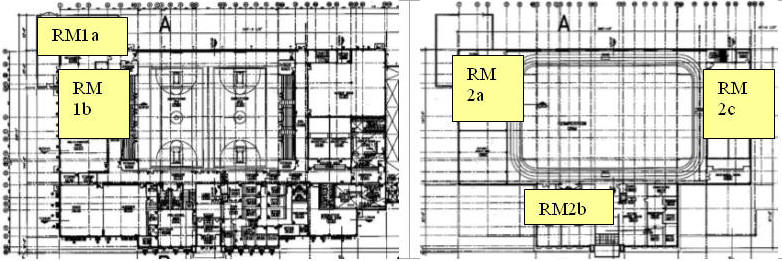|
Building Statistics
Building
Name:
Pearland Recreation Center and Natatorium

Figure 1.1: Architects rendering of the recreation center
entrance. (Courtesy of PBK)
Location: 4141 Bailey Rd.
Pearland, TX 77584
Building
Occupant: Residents of Pearland, Texas
Building
Type:
Athletics
Size: Complete
Building: 105,117 Square Feet
Recreation Center: 63,300 Square Feet
Natatorium: 41,817 Square Feet
Total
Levels:
2
Project
Team:
Dates of
Construction: May 2009 June 2010
Cost: ~$17 Million, exact
amount confidential (Contract with contractor EMJ Corporation)
Delivery
Method: Design-Bid-Build/Competitive Bid/Lump Sum
The
Pearland Recreation Center and Natatorium houses a recreation center and
natatorium. The building spans 638-1 and is 230-1 wide. The
natatorium is located on the eastern half of the building and is connected
to the recreation center on the opposite half of the building.
 
Figure
1.2: First floor plan

Figure 1.3: Second floor plan
The 2-story
recreation portion of the building contains a double height competitive gym
that can seat 588 spectators and has a raised 4-lane running track around
the perimeter. There is also a dance room, aerobics room, weight
room, 2 racquetball courts, locker rooms, offices, and other multi-purpose
rooms.
The double
height natatorium contains an 8-lane 50 meter competition pool and a 4-lane
25 yard instructional pool with a handicap ramp. The competition pool
includes a moveable bulkhead, (2) 1-meter diving boards, and (2) 3-meter
diving boards. There is seating for 694 spectators in bleachers
surrounding the competition pool. There are also equipment rooms and
training rooms in this portion of the building.
Building
Codes:
2003
International Building Code
2003
International Plumbing Code
2003
International Mechanical Code
2003
International Electrical Code
2003
International Energy Code
2003
International Fire Code
2003 International
Gas Code
1994 Texas
Accessibility Standards
1992
Americans with Disabilities Act
Zoning:
Zoning
District GB (General Business)
|
|
Requirements
|
Actual
|
|
Minimum
Lot Size
|
22,500
Square Feet
|
330,090
Square Feet
|
|
Minimum
Lot Width
|
150-0
|
727-7
(Frontage on Bailey Road)
|
|
Minimum
Lot Depth
|
125-0
|
453-8
|
|
Building
Setback: Front
|
25-0
Minimum
|
212-6
|
|
Building
Setback: Rear
|
25-0
Minimum
|
32-9
|
|
Building
Setback: Side
|
10-0
Minimum
|
34-6
|
|
Height
Restriction
|
45-0
Maximum Height
|
44-11
|
Historical
Requirements:
There are
no historical requirements on this project.
Building
Facades:
The facades
are primarily face brick on horizontally reinforced 8 CMU with rigid
insulation and damp proofing between. The facades by the recreation
center and natatorium entrances are calcium silicate masonry units on
horizontally reinforced 8 CMU with rigid insulation and damp proofing
between. All the glazing is Ό Tinted Tempered Float Glass. The
four facades are described below:
The
south faηade, facing Bailey Road is 25% glazing.

Figure 1.4: South Exterior Elevation
The
north faηade has 10 windows

Figure 1.5: North Exterior Elevation
The east
faηade has a series of strip windows along the recreation center entrance

Figure 1.6: East Exterior Elevation
The west
faηade has 10 windows plus a strip window at the recreation entrance

Figure 1.7: West Exterior Elevation
Roofing:
The roof in
the recreation center is a steel truss system while the roof in the
natatorium is a glulam truss system. The roofing system throughout
the recreation center and natatorium consists of standing seam metal roof
on a fully adhered waterproof membrane. The roofing system over the
main entrance to the building on the south side, a small strip between the
recreation area and natatorium, and over a small portion of the north side
of the natatorium is modified bitumen.

Figure 1.8: Construction photo of roof trusses at recreation
center (Courtesy of EMJ Corporation)
This
building has no sustainable features.
Pearland
Recreation Center and Natatorium project is utilizing a Design-Bid-Build
delivery method with a hard bid lump sum contract for the general
contractor and specialty contractors. The project is being developed
through a joint-partnership between the City of Pearland and Pearland
Independent School District. City of Pearland holds the contracts
with the designers and contractors and is overseeing construction, while
Pearland Independent School District has donated the land and a portion of
the construction cost.
Pearland,
Texas is a suburb 15-miles south of Houston, Texas and the 8-acre site is
located in an unpopulated but easily accessible location. For this
reason site logistics will not be an issue during construction. There
will be ample room for steel shake-out, material storage, and contractor
parking throughout construction.
Site
elevation is only 7-feet above sea level so it is necessary to dewater the
site during excavation and foundation construction using well-points.
Excavation will use a 1:1 layback. Steel and glulam structural system
construction will utilize 50, 75, 80, and 100 ton truck cranes, all to be provided
by the specialty contractor. All concrete will be placed using a pump
truck.
Electric
power is supplied to the building from an existing above ground power line
that parallels Veterans Drive on the west side of the building. A
3000A power source is supplied to the main transformer in the mechanical
courtyard at the northwest corner of the building. There is also a
400 KW emergency generator. From the 408/277 Volt main distribution
panel there are 29 surface mounted panel boards, 12 of which are connected
to the emergency generator. These 12 circuits are evenly spread
throughout the building, supplying power to critical equipment and lighting
in public areas. Of the 29 panel boards, 15 are 408/277 Volt 3PH 4W
and 14 are 208/120 Volt 3PM 4W. Each of the 14 208/120 Volt panels is
stepped down using a 30KVA transformer.
There are
32 different light fixtures in the Pearland Recreation Center and
Natatorium. All but 3 of these are powered by 277V. One is
powered by 120V and two have a 480V power source. A 2X4 recessed
fixture with (3) T-8 lamps, a 0.125 thick lens, and a CCT of 4100K is the
predominately used fixture. This fixture is used in the offices,
multi-purpose rooms, storage rooms, corridors, restrooms, and the weight
room. Two other fixtures that are important to note are a pendent (6)
T-5 lamps, 3-ballast, high impact acrylic lens that is used in the
gymnasium and a suspended 1000W metal halide Lightruss system that is used
in the natatorium. The Lightruss system, shown below in Figure 2.1,
is a fixture type that is frequently used in natatoriums.

Figure 2.1 Lightruss system in a natatorium (courtesy of SPI
Lighting)
Pearland
Recreation Center and Natatoriums uses a constant air volume mechanical
system consisting of chillers and air handling units servicing fan-powered
constant volume terminals in each room. There are (12) AHUs located
throughout the building ranging in capacity from a 2,000 CFM AHU which
services the 2nd floor offices to a 46,500 CFM AHU which
services the natatorium. These AHUs are served by (2) 138-ton, 240
GPM chillers located in the mechanical room courtyard at the northwest
corner of the building. Figures 2.2-2.5 and Table 2.6 show the
locations of the mechanical rooms and the equipment contained in each.

Figure 2.2 Rec Center 1st Floor Mechanical Room
Locations
Figure 2.3 Rec Center 2nd Floor Mechanical Room Locations

Figure 2.4 Natatorium 1st Floor Mechanical Room
Location
Figure 2.5 Natatorium 2nd Floor Mechanical Room Location
Table 2.6 Mechanical Equipment List
|
Location
|
Item
|
|
RM1a
|
Two (2)
Air Cooled Chillers
|
|
RM1b
|
Four (4)
End Suction Pumps
|
|
RM2a
|
Two (2)
Air Handling Units, Two (2) Boilers, and One (1) End Suction Pump
|
|
RM2b
|
Three (3)
Air Handling Units
|
|
RM2c
|
Four (4)
Air Handling Units
|
|
NM1
|
One (1)
Air Handling Unit and One (1) Condenser
|
|
NM2
|
Two (2)
Air Handling Units
|
The
structural system for Pearland Recreation Center and Natatorium consists of
structural steel throughout the building however there is a glulam system
over the swimming pools. Since the building has a wide variety of
room types, there is also a variation in live load design requirements (60
psf 150 psf) throughout the building. This has led to many
different member sizes in the building. Steel columns are tube steel
and consist of six (6) different sizes ranging from TS 10x10x3/8 to TS
4x4x1/4. Second floor framing consists of W-section beams ranging in
size from W12x19 to W30x90 that support LH and K-Series floor joists spaced
at 2-6 o.c. LHSP joists spaced at 5-0 o.c. are used for the roof
in the recreation center.
As
previously mentioned, a glulam system is used in the natatorium over the
swimming pools. A total of 14 glulam columns/beams are used to
support 5x16 glulam purlins spaced at 10-0 o.c.
Foundations
for the building consist of drilled concrete piers and spread
footings. Concrete piers are 6 in diameter using 3000 psi and are
drilled and poured to 12 below finished floor. There are about 100
of these piers. At the base of each column is a 2x2x1 concrete
spread footing.
The slab on
grade is a 5 thick concrete slab with #3 bars at 14 o.c. each way on 3
chairs at 42 o.c. The entire slab is 3000 psi concrete on 15mil
plastic water vapor barrier on compacted fill. There are 2 ½
depressions in the slab on grade at the gymnasium, dance/aerobics room,
weight room, and the racquetball courts.
Elevated
concrete slabs are 3 thick 3500 psi concrete with 6x6 WWF reinforcing on
a 9/16 thick corrugated metal deck. Roof decking over the open-web
steel joists is 1 ½ deep 22 ga type B steel decking, while the roof
decking over the glulam columns/beams is a 3 longspan cementitious wood
fiber decking.
Pearland
Recreation Center and Natatorium has a wet pipe pre-action fire sprinkler
system that is to be built to a performance spec of:
Public
Spaces, Classrooms, and Offices: 0.10 GPM/SF over the most remote 1,500 SF.
Mechanical
Rooms, Storage Areas, and Service Areas: 0.15 GPM/SF over 1,500 SF.
|